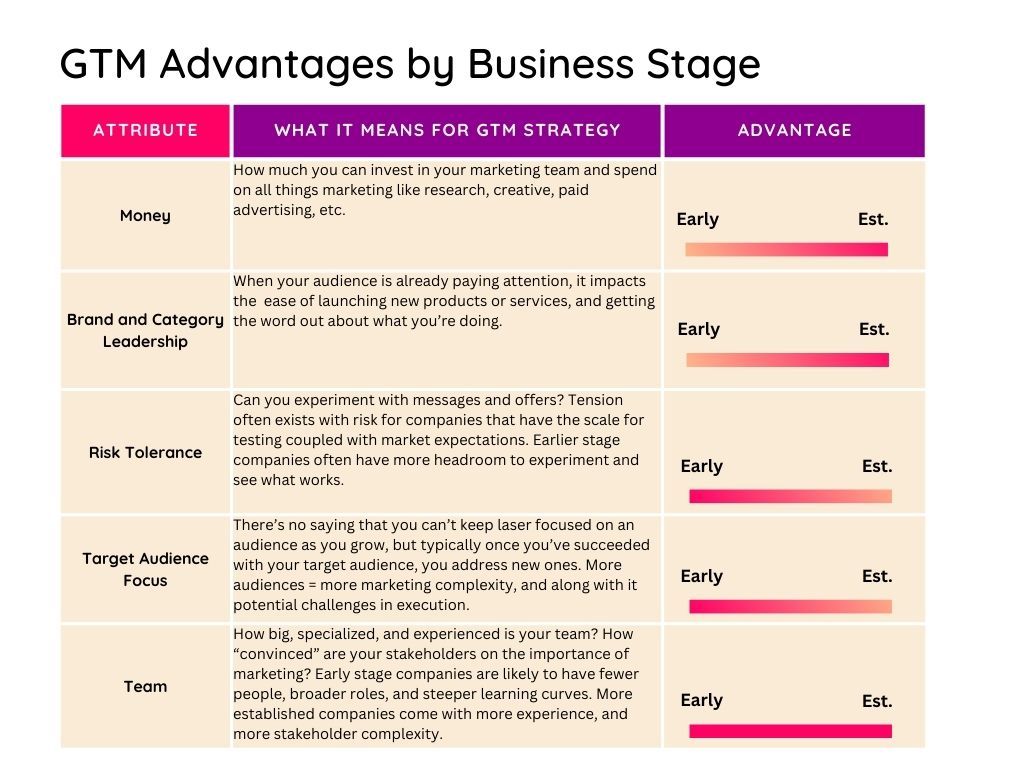If you’ve been a marketing leader for long enough, chances are you’ve worked in companies of different stages and sizes across industries. And you may have noticed along the way that what works for a big, well-established brand doesn’t work for, say, a small, early-stage growth start-up.
There are a lot of reasons why marketing strategies are different based on the size and stage of a company, and it likely has a lot to do with money, brand and category leadership, risk tolerance, audience focus, and the team.

Everything above impacts your timelines, how innovative your strategy and approach can be, the scope of tactics available to deploy, and the results you can reasonably expect from your efforts. So what best practices for GTM strategy can you follow in any context?
Same stuff, different context
At Aeon Muse Product Marketing, we get to work with clients who are at different stages of business – from the early stage founder-led start-up looking to figure out product-market fit and gain traction with early customers, to established category leaders introducing new products or services.
No matter the stage or the industry, these approaches to building a GTM strategy keep proving they’re one size fits most.
The one-size-fits-most approach to building a GTM Strategy
Assign clear ownership.
Who’s building the GTM Strategy, for starters? If you’re early-stage, maybe it’s you. If you’re a more established company and this is for product #1,467, it’s probably someone on your team or even several members of your team collaborating. Whether DACI, RACI, or some other acronym holds your roles and responsibilities framework of choice, use it. Work inside out from who’s building the plan and marketing strategy assets, and use it for all aspects of the plan and tactics to make sure the right people are involved at the right time.
Don’t skimp on the strategy.
Even if you’re “moving fast” and/or find marketing in a reactive vs. proactive position to take something to market, pause and spend time on the strategy, otherwise, you’re just creating a tactical plan. As you know, hours on strategy at the start can save days, weeks, or months, later on. That doesn’t mean everyone in your organization will always be on board with the need for a strategy. As a CMO, champion the need for marketing strategy before jumping straight into action.
The first questions that you’ll need to answer through the strategy is why this, why now, and what success will look like. You then always need to:
- build a target audience definition, profile, or persona (who’s it for, what are their problems or jobs to be done). Multiple audiences? Repeat and refine the next items as needed by audience.
- define the benefits of the solution (how do we solve our audience’s problems)
- identify the audience’s alternatives (competitive intelligence)
- tell the story to the target audience that you’ve got what they need (positioning and messaging)
- outline how the audience can buy it (pricing, packaging, purchase flow/operations that support purchase).
- call out any guardrails on things you won’t do, or that’s out of scope for this strategy
- sketch out any future phases of the strategy
Even if you’re a marketing team of one, in an organization of one, make a slide deck to capture this strategy, and build out any components you need more detail on - like positioning - in a document. For bigger organizations, putting this on paper helps surface decisions, knowledge gaps, and more for better alignment. This executive-level deck should work for socializing the plan with peers and make it easy to share what your team is up to.
Create an obsessively specific tactical plan.
When you need to move a large group of people to take something to market, creating detailed tactical plans is an intuitive way to make it happen.
For early-stage companies, this could feel like overkill. Do you really need a line-by-line tactical plan with everything you’re doing, including a description of the tactic, start dates, in-market dates, owner(s) and collaborators, status, notes, and KPIs by tactic? YES! Especially when resources are scarce, creating an exhaustive list of tactics will help you as a marketing leader make necessary tradeoffs between effort, expense, and impact. What’s more, if you’re in a more flexible testing mode, capturing what you do and how it performs is going to help you learn faster.
Teaching your teams to detail out what they’re doing in a tactical plan will help you as a leader easily be able to see who’s doing what, and help the team prioritize or re-prioritize on as needed to make sure the most important things are always getting done.
And finally, measure and keep iterating
Go-to-market strategy is an ongoing business strategy - it’s not the same as a launch strategy. Your GTM strategy may be something you revisit monthly, quarterly, or annually and serves the north star for what your marketing organization does.
How ambitious your KPIs are, and your ability to track them, will depend in part on your stage of company. But developing a practice around measuring, building insights and hypotheses on why something succeeded or failed, and iterating continuously will take your strategy off the page and into your team’s operating cadence, and improve your market position over time.
Do you have a go-to framework for GTM? Need help building one? Join the conversation with a global network of CMOs and marketing leaders on the CMO Alliance Community Slack channel.




 Follow us on LinkedIn
Follow us on LinkedIn



